check engine light AUDI TT COUPE 2016 Owner's Manual
[x] Cancel search | Manufacturer: AUDI, Model Year: 2016, Model line: TT COUPE, Model: AUDI TT COUPE 2016Pages: 322, PDF Size: 52.86 MB
Page 224 of 322
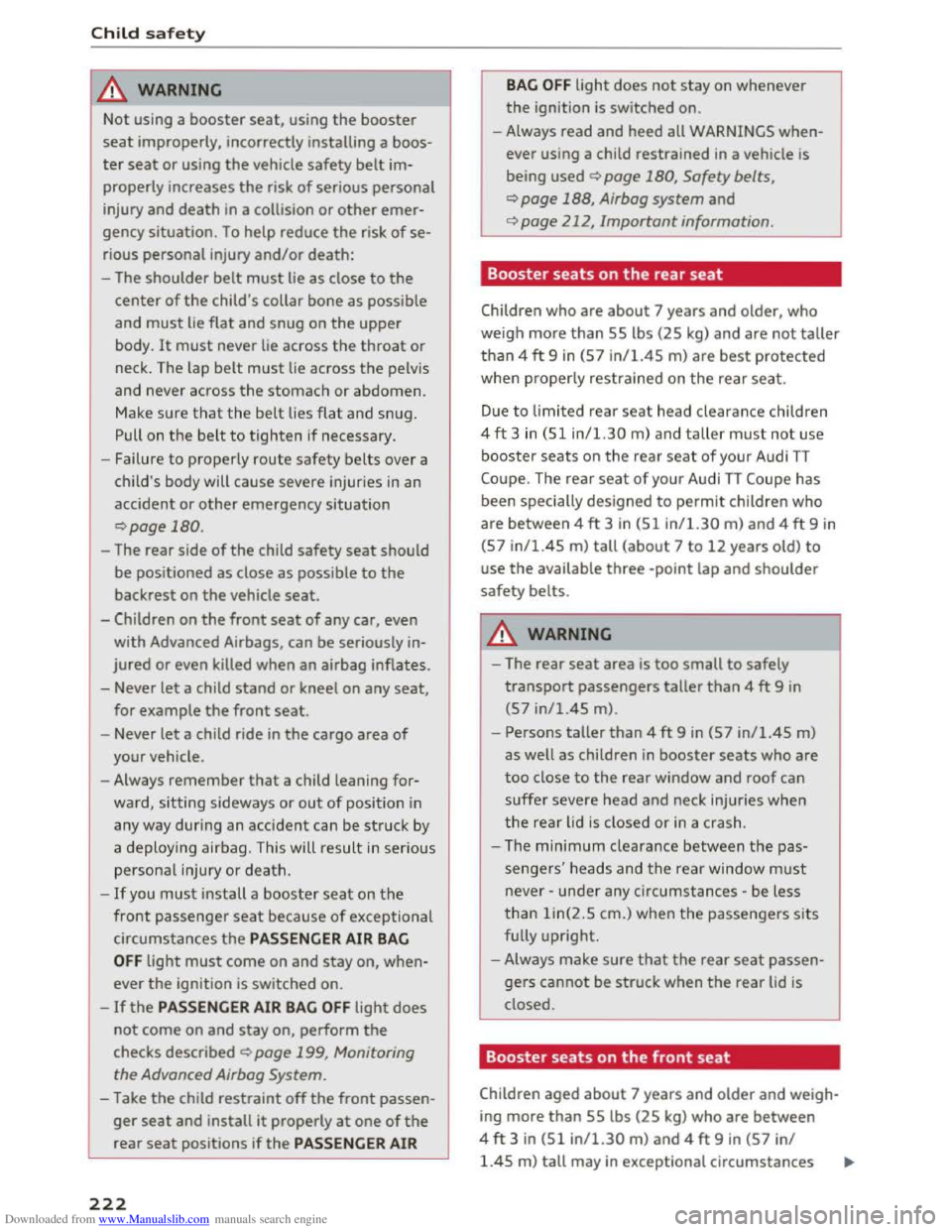
Downloaded from www.Manualslib.com manuals search engine Child safety
.&_ WARNING
Not using a booster seat, using the booster
seat improperly, incorrectly installing a boos
ter seat or using the vehicle safety belt im
properly increases the risk of serious personal
injury and death in a collision or other emer
gency situation. To help reduce the risk of se
rious personal injury and/or death:
-The shoulder belt must lie as close to the
center of the child's collar bone as possible
and must lie flat and snug on the upper
body. It must never lie across the throat or
neck. The lap belt must lie across the pelvis
and never across the stomach or abdomen.
Make sure that the belt lies flat and snug.
Pull on the belt to tighten if necessary.
- Failure
to properly route safety belts over a
ch i
ld's body will cause severe injuries in an
accident or other emergency situation
qpage 180.
-The rear side of the child safety seat should
be positioned as close as possible to the
backrest on the vehicle seat.
-Children on the front seat of any car, even
with Advanced Airbags, can be seriously in
jured or even killed when an airbag inflates.
- Never
let a child stand or kneel on any seat,
for example the front seat.
-Never let a child ride in the cargo area of
your vehicle .
- Always
remember that a child leaning for
ward, sitting sideways or out of position in
any way
during an accident can be struck by
a deploying airbag. This will
result in seriou s
personal injury or death.
-If you must install a booster seat on the
front passenger seat because of exceptional
circumstances the PASSENGER AIR BAG
OFF light must come on and stay on, when
ever the ignition is switched on.
-If the PASSENGER AIR BAG OFF light does
not come on and stay on, perform the
checks described q page 199, Monitoring
the Advanced Airbag System.
-Take the child restraint off the front passen
ger seat and install it properly at one of the
rear seat positions if the PASSENGER AIR
222
BAG OFF light does not stay on whenever
the ignition is switched on.
- Always
read and heed all WARNINGS when
ever using a child restrained in a vehicle is
being
used q page 180, Safety belts,
q page 188, Airbag system and
q page 212, Important information.
Booster seats on the rear seat
Children who are about 7 years and older, who
weigh more than SS lbs (2S kg) and are not taller
than 4 ft 9 in (S7 in/1.4S m) are best protected
when properly restrained on the rear seat.
Due to limited rear seat head clearance chi ld ren
4 ft 3 in (Sl in/1.30 m) and taller must not use
booster seats on the rear seat of your Audi TT
Coupe. The rear seat of your Audi TT Coupe has
been specially designed to permit children who
are between 4 ft 3 in (Sl in/1.30 m) and 4 ft 9 in
(S7 in/1.4S m) tall (about 7 to 12 years old) to
use the available three -point lap and shoulder
safety belts.
.&. WARNING
lo= ----The rear seat area is too small to safely
transport passengers taller than 4 ft 9 in
(S7 in/1.4S m).
-
Persons taller than 4 ft 9 in (S7 in/1.4S m)
as well as children in booster seats who are
too close to the rear window and roof can
suffer severe head and neck injuries when
the rear lid is closed or in a crash.
- The
minimum clearance between the pas
sengers' heads and the rear window must
never -under any circumstances -be less
than l in(2.S cm.) when the passengers sits
fully upright.
- Always make sure that the rear seat passen
gers cannot be struck when the rear lid is
closed.
Booster seats on the front seat
Children aged about 7 years and older and weigh
ing more than SS lbs (2S kg) who are between
4 ft 3 in (Sl in/1.30 m) and 4 ft 9 in (S7 in/
l.4S m) tall may in exceptional circumstances ~
Page 226 of 322
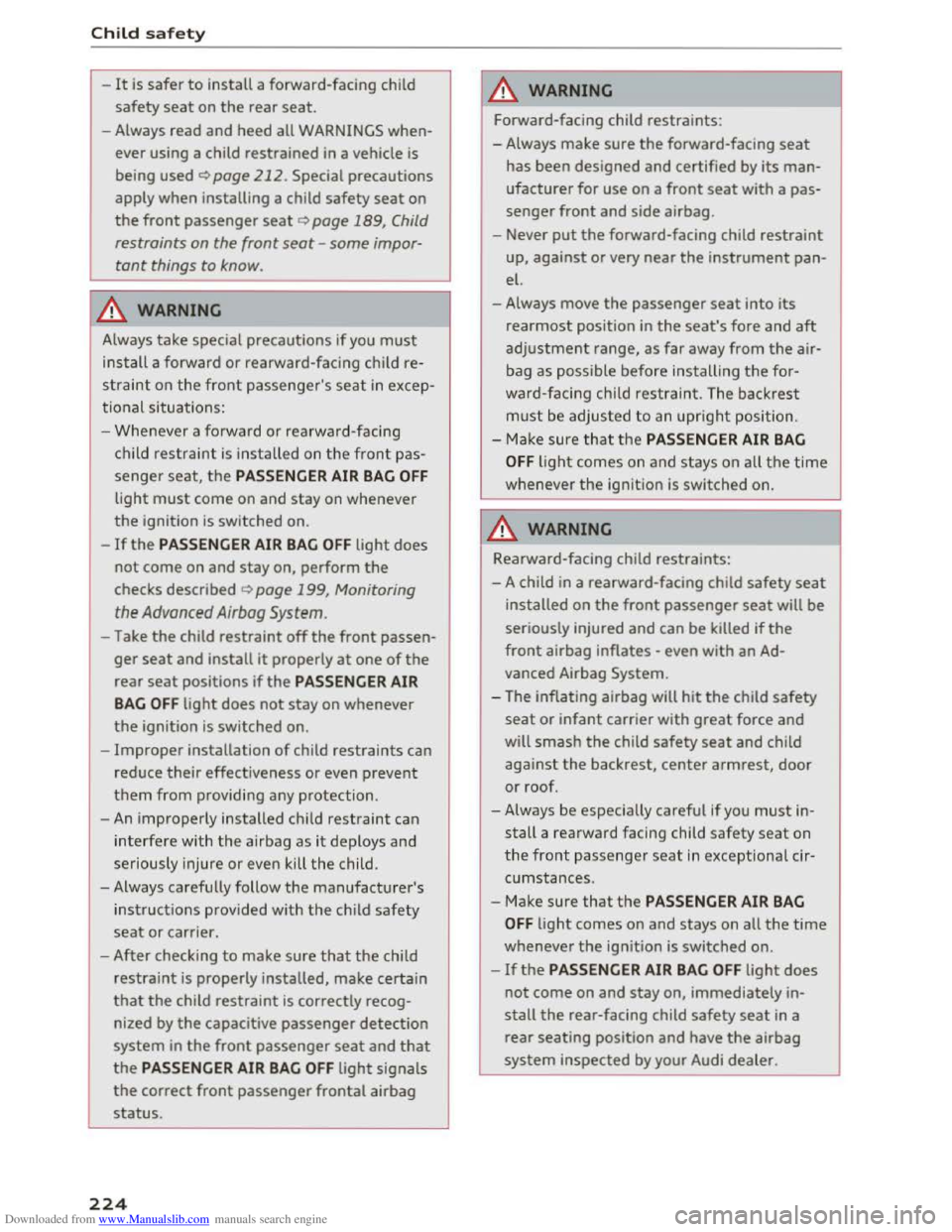
Downloaded from www.Manualslib.com manuals search engine Child safety
-It is safer to install a forward-facing child
safety seat on the rear seat.
-Always read and heed all WARNINGS when
ever using a child restrained in a vehicle is
being used c'.) page 212. Special precautions
apply when installing a child safety seat on
the front passenger seat c'.) page 189, Child
restraints on the front seot -some impor
tant things to know.
..&_WARNING
....
Always take special precautions if you must
install a forward or rearward-facing child re
straint on the front passenger's seat in excep
tional situations:
- W
henever a forward or rearwa rd-facing
chi ld r
estraint is installed on the front pas
senger seat, the PASSENGER AIR BAG OFF
ligh t must come on and stay on whenever
the ignition is switched on.
-
If the PASSENGER AIR BAG OFF light does
not come on and stay on, perform the
checks described c'.) page 199, Monitoring
the Advanced Airbag System.
-Take the child restraint off the front passen
ger seat and install it properly at one of the
rear seat positions if the PASSENGER AIR
BAG OFF light does not stay on whenever
the ignition is switched on.
-
Improper installation of child restraints can
reduce their effectiveness or even prevent
them from providing any protection.
-An improperly installed child restraint can
interfere with the airbag as it deploys and
seriously injure
or even kill the child .
-Always carefu lly follow the manufacturer's
instructions prov ided with the child safety
seat or carrier.
- After checking
to make sure that the child
restraint is properly installed, make certain
that the child restraint is correctly recog
nized by the capacitive passenger detection
system in the front passenger seat and that
the PASSENGER AIR BAG OFF light signals
the correct front passenger frontal airbag
status.
224
-
..&. WARNING
Forward-facing child restraints:
-Always make sure the forward-facing seat
has been designed and certified by its man
ufacturer for use on a front seat with a pas
senger front and side airbag.
- Never
put the forward-facing child restraint
up, against or very near the instrument pan
el.
-Always move the passenger seat into its
rearmost position in the seat's fore and aft
adjustment range, as far away from the air
bag as possible before installing the for
ward-facing child restraint. The backrest
m ust be adjusted to an upr ight position.
- M ake
sure that the PASSENGER AIR BAG
OFF light comes on and stays on all the time
whenever the ign ition is switched on.
..&_WARNING
Rearward-facing child restraints:
-A ch ild in a rearward-facing child safety seat
installed on the front passenger seat will be
seriously injured
and can be killed if the
front airbag inflates -even with an Ad
vanced Airbag System.
-The inflating airbag will hit the child safety
seat or infant carrier with great force and
will smash the child safety seat and child
against the backrest, center armrest, door
or roof.
-Always be especia lly careful if you must in
stall a rearward facing child safety seat on
the front passenger seat in exceptiona l cir
cumstances.
- Make
sure that the PASSENGER AIR BAG
OFF light comes on and stays on all the time
whenever the ignition is switched on.
-If the PASSENGER AIR BAG OFF light does
not come on and stay on, immediately in
stall the rear-facing child safety seat in a
rear seating position and have the airbag
system inspected by your Audi dealer.
Page 233 of 322
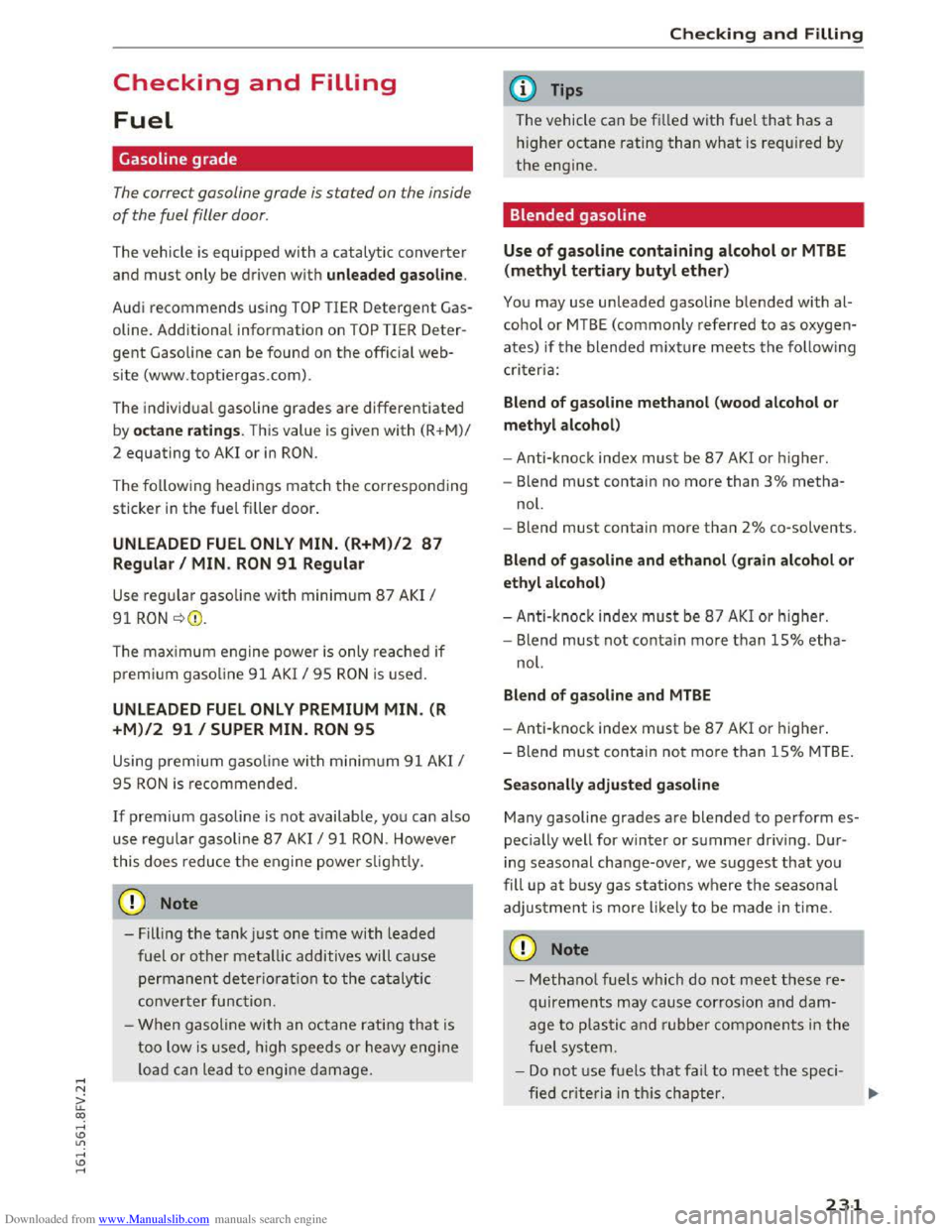
Downloaded from www.Manualslib.com manuals search engine Checking and Filling
Fuel
Gasoline grade
The correct gasoline grade is stated on the inside
of the fuel filler door.
The vehicle is equipped with a catalytic converter
and must only be driven with unleaded gasoline.
Audi recommends using TOP TIER Detergent Gas
oline. Additional information on TOP TIER Deter
gent Gasoline can be found on the official web
site (www.toptiergas.com).
The individual gasoline grades are differentiated
by octane ratings. This value is given with (R+M)/
2 equating to AKI or in RON.
The following headings match the corresponding
sticker in the fuel filler door.
UNLEADED FUEL ONLY MIN. (R+M)/2 87
Regular I MIN. RON 91 Regular
Use regular gasoline with minimum 87 AKI I
91 RON ~CD.
The maximum engine power is only reached if
p r
emium gasoline 91AKII95 RON is used.
UNLEADED FUEL ONLY PREMIUM MIN. (R
+M)/2 91 I SUPER MIN. RON 95
Using premium gasoline with minimum 91 AKI I
95 RON is recommended.
If premium gasoline is not available, you can also
use regular gasoline 87 AKI I 91 RON. However
this does reduce the engine power slightly.
CD Note
-Fill ing the tank just one time with leaded
fuel or other metallic additives will cause
permanent deterioration to the catalytic
converter function.
-When gasoline with an octane rating that is
too low is used, high speeds or heavy engine
load
can lead to engine damage.
Checking and Filling
{!) Tips
The vehicle can be filled with fuel that has a
higher octane rating than what is required by
the engine.
Blended gasoline
Use of gasoline containing alcohol or MTBE
(methyl tertiary butyl ether)
You may use unleaded gasoline blended with al
cohol or MTBE (commonly referred to as oxygen
ates) ifthe blended mixture meets the fo llowing
criteria:
Blend of gasoline methanol (wood alcohol or
methyl alcohol)
-Anti-knock index must be 87 AKI or higher.
- Blend must contain no more than 3% metha-
nol.
- Blend
must contain more than 2o/o co-solvents.
Blend of gasoline and ethanol (grain alcohol or
ethyl alcohol)
-Anti-knock index must be 87 AKI or higher.
- Blend must not contain more than 15% etha-
nol.
Blend of gasoline and MTBE
-Anti-knock index must be 87 AKI or higher.
- Blend must contain not more than 15% MTBE.
Seasonally adjusted gasoline
Many gasoline grades are blended to perform es
pecially well for winter or summer driving . Dur
ing
seasonal change-over, we suggest that you
fill
up at busy gas stations where the seasonal
adjustment is more likely to be made i n time.
CD Note
-Methanol fuels which do not meet these re
quirements may cause corrosion and dam
age to plastic and rubber components in the
fuel system.
-Do not use fuels that fail to meet the speci-
fied
crit eria in this chapter. ll>
231
Page 239 of 322
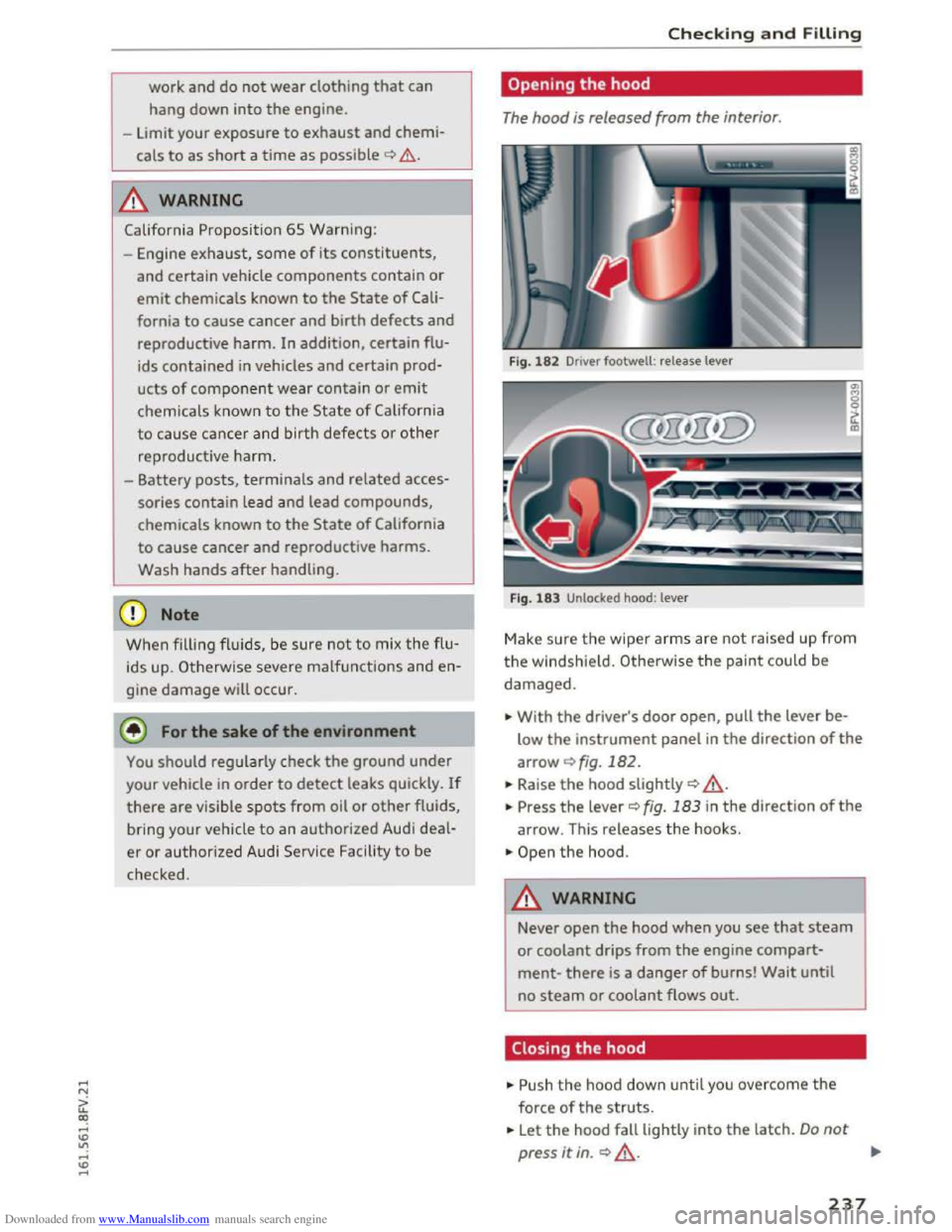
Downloaded from www.Manualslib.com manuals search engine work and do not wear clothing that can
hang down into the engine.
-Limit your exposure to exhaust and chemi
cals to as short a time as possible c::> &..
/Jj._ WARNING
California Proposition 65 Warning:
- Engine
exhaust, some of its constituents,
and certain vehicle components contain or
emit chemicals known to the State of Cali
fornia to cause cancer and birth defects and
reproductive harm. In addition, certain flu
ids
contained in vehicles and certain prod
ucts of component wear contain or emit
chemicals known to the State of California
to cause cancer and birth defects or other
reproductive harm.
-Battery posts, terminals and related acces
sories contain lead
and lead compounds,
chemicals known to the State of California
to cause cancer and reproductive harms.
Wash hands after handling.
CD Note
When filling fluids, be sure not to mix the flu
ids up.
Otherwise severe malfunctions and en
gine damage will occur.
@ For the sake of the environment
You should regularly check the ground under
your vehicle in order to detect leaks quickly. If
there are visible spots from oil or other fluids,
bring your vehicle
to an authorized Audi deal
er or authorized Audi Service Facility to be
checked.
Checking and Filling
Opening the hood
The hood is released from the interior.
Fig. 182 Driver footwell : release lever
Fig.
183 Unlocked hood: lever
Make sure the wiper arms are not raised up from
the windsh ield. Otherwise the paint could be
damaged.
... With the driver's door open, pull the lever be
low the instrument panel in the direction of the
arrowc::>fig.182 .
... Raise the hood slightly c::> ,&.
... Press the lever c::>fig. 183 in the direction of the
arrow. This releases the hooks.
.. Open the hood.
.&. WARNING
Never open the hood when you see that steam
or coolant drips from the engine compart
ment-there is a danger of burns! Wait until
no steam or coolant flows out.
Closing the hood
.. Push the hood down until you overcome the
force of the struts .
... Let the hood fall lightly into the latch. Do not
press it in. c::> ,&. ...
237
Page 241 of 322
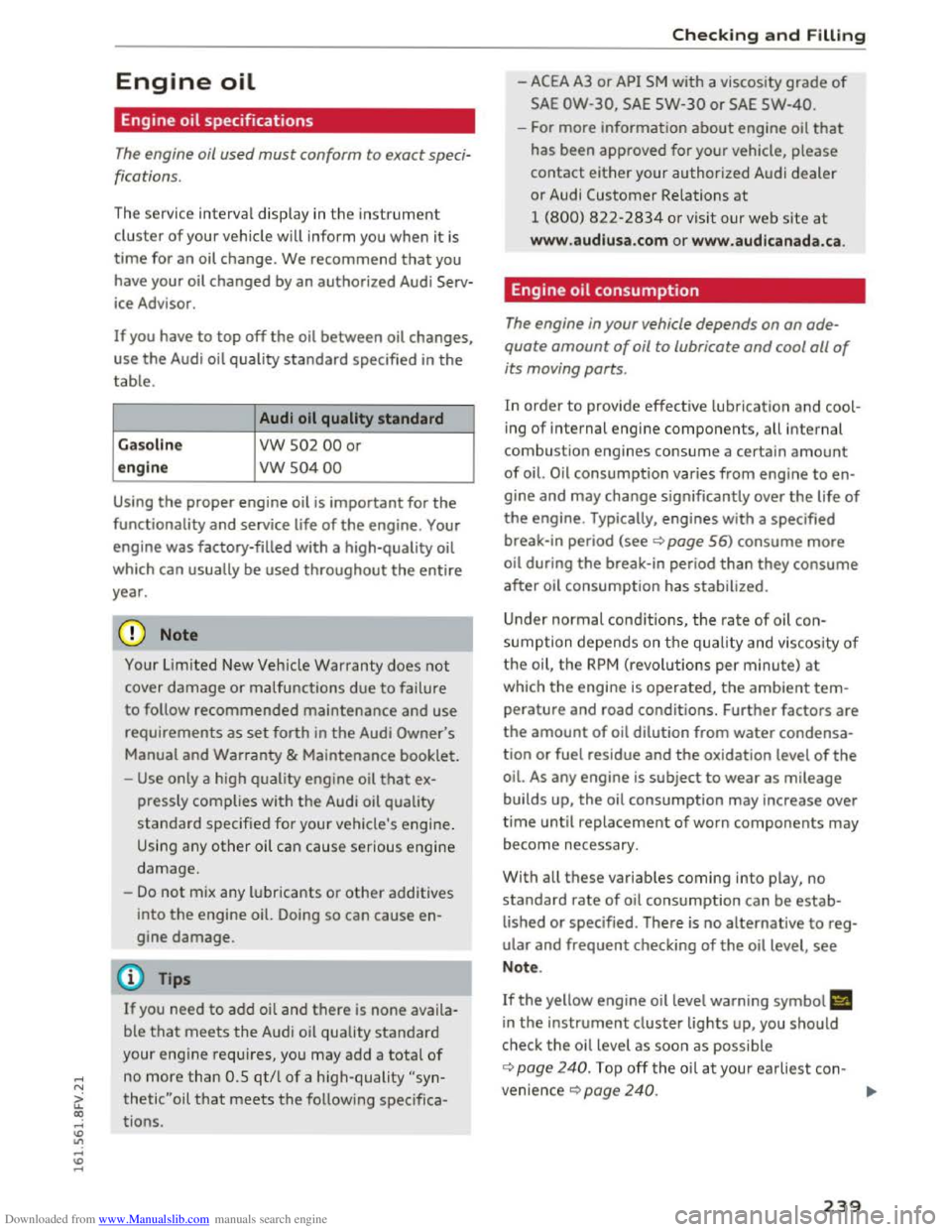
Downloaded from www.Manualslib.com manuals search engine Engine oil
Engine oil specifications
The engine oil used must conform to exact speci
fications.
The ser vice interva l disp lay in the instrument
cluster of your vehicle will inform you when it is
time for an oil change . We recommend that you
have your
oil changed by an authorized Audi Serv
ice Advisor.
If you have to top off the oil between oil changes,
use the Audi oil quality standard specified in the
table.
Audi oil quality standard
G
asoline VW S02 00 or
engin e vw S0400
Using the proper engine oil is important for the
functionality and service life of the engine. Your
engine was factory-filled
with a high-quality oil
which
can usually be used throughout the entire
year.
CD Note
Your Limited New Vehicle Warranty does not
cover damage or malfunctions due to failure
to follow recommended maintenance and use
requirements as set forth in the Audi Owner's
Manual and Warranty
& Maintenance booklet.
-
Use only a high quality engine oil that ex-
pressly complies
with the Audi oil quality
standard specified for your vehicle's engine.
Using any other oil can cause serious engine
damage.
-
Do not mix any lubricants or other additives
into the engine oil. Doing so can cause en
gine damage.
Tips
If you need to add oil and there is none availa
ble
that meets the Audi oil quality standard
your engi
ne requires, you may add a tota l of
no more than O.S qt/l of a high-quality "syn
thetic" oil that meets the following spec ifica
tions.
Checking and F illing
-ACEA A3 or API SM with a viscosity grade of
SAE OW-30, SAE SW-30 or SAE SW-40.
-For more information about engine oil that
has been approved for your vehicle, please
contact either your
authorized Audi dealer
or Audi Customer
Relations at
1 (800) 822-2834 o r visit our web site at
www .audiusa .com or www.audicanada .ca.
Engine oil consumption
The engine in your vehicle depends on an ade
quate
amount of oil to lubricate and cool all of
its moving parts.
In order to provide effective lubrication and cool
i ng
of internal engine components, all internal
combustion engines consume a certa in amount
of oil. Oil consumption varies from engine to en
gine and may change significantly over
the life of
the engine. Typically, engines with a specified
break-in period
(see~ page 56) consume more
oil during the break-in period than they consume
after oil consumption has stabilized.
Under normal cond it ions, the rate of oil con
s u
mption depends on th e qu ality and viscos ity of
the oil, the RPM (revolutions per minute) at
which the engine is operated, the ambient tem
perature and road conditions. Further factors are
the amount of oil dilution from water condensa
tion or fuel residue and the oxidation level of the
oil. As any engine is subject to wear as mileage
builds
up, the oil consumption may increase over
t ime
until replacement of worn components may
become necessary.
With all these variab les coming into play, no
standard rate
of oil consumption can be estab
lished
or specified. There is no alternative to reg
ular and frequent checking of the oil level, see
Note .
If the yellow engine oil level warning symbol II
in the instrument cluster lights up, you should
check
the oil level as soon as possible
~page 240. Top off the oil at your earliest con-
venience
Q page 240. ..,..
239
Page 245 of 322
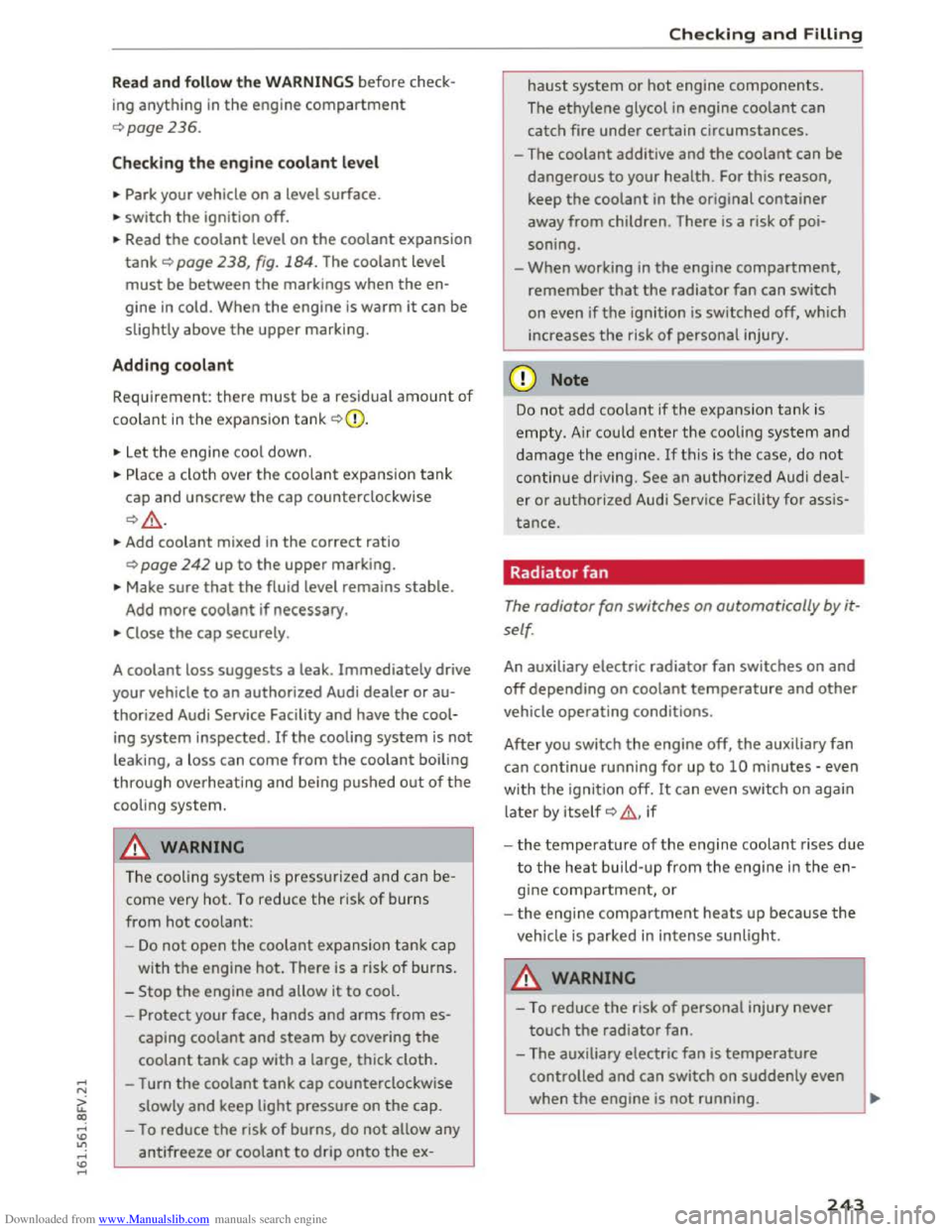
Downloaded from www.Manualslib.com manuals search engine ...... N
> u. CX> ...... u:>
"' ...... u:> ......
Read and follow the WARNINGS before check
ing anything
in the engine compartment
Qpage236.
Checking the engine coolant level
""Park your vehicle on a level surface.
"" switch the ignition off.
.. Read the coolant level on the coolant expansion
tank
Q page 238, fig. 184. The coolant level
must be between the markings when the en
gine
in cold. When the engine is warm it can be
slightly above
the upper marking.
Adding coolant
Requirement: there must be a res idual amount of
coo l
ant in the expans io n tank c:?(i) .
""Let the engine cool down.
.. Place a cloth over the coolant expansion tank
cap and unscrew
the cap counterclockwise
c:?,8..
""Add coolant mixed in the correct ratio
i:?page 242 up to the upper marking.
""Make sure that the fluid level remains stable.
Add more coolant if necessary.
"" Close the cap securely .
A coolant loss suggests a leak. Immediately drive
your vehicle
to an authorized Audi dealer or au
thorized
Audi Service Facility and have the cool
ing system inspected.
If the cooling system is not
leaking, a loss can come from
the coolant boiling
through overheating and being pushed
out of the
cooling system.
.&. WARNING
-The cooling system is pressurized and can be-
come very hot.
To reduce the risk of burns
from hot coolant:
-
Do not open the coolant expansion tank cap
w ith
the engine hot. There is a risk of burns .
- Stop
the engine and allow it to cool.
-
Protect your face, hands and arms from es-
caping coolant and
steam by covering the
coolant tank cap with a large, thick cloth.
- Turn
the coolant tank cap counterclockwise
slowly and keep light pressure on
the cap.
-
To reduce the risk of burns, do not allow any
antifreeze or coolant to dr
ip onto the ex-
Checking and Filling
ha ust system or hot engine components.
The ethylene glycol in engine coolant can
catch fire under certain circumstances.
- The coolant additive and the coolant can be
dangerous to your health.
For this reason,
keep
the coolant in the original container
away from children. There is a
risk of poi
soning.
-When working in the engine compartment,
remember
that the radiator fan can switch
on even if
the ignition is switched off, which
increases
the risk of personal injury.
CD Note
Do not add coolant if the expans ion tank is
empty . Air could enter the cooling system and
damage
the eng ine. If this is the case, do not
continu e driving. See an authorized
Audi dea l
er or authorized
Audi Service Facility for assis
tance.
Radiator fan
The radiator fan switches on automatically by it
self.
An auxiliary electric radiator fan switches on and
off depending on coolant temperature and other
vehicle operating conditions.
After you switch
the engine off, the auxiliary fan
can continue running for
up to 10 minutes -even
with
the ignit ion off. It can even switch on again
later by itself c:? & . if
- the temperature of
the engine coolant rises due
to
the heat build-up from the engine in the en
gine compartment, or
-
the engi ne compartment heats up because the
vehicle is parked in intense sunlight.
.&. WARNING
-To reduce the risk of personal injury never
touch
the radiator fan.
- The auxiliary electric fan
is temperature
controlled and can switch on suddenly even
when
the engine is not running.
243
Page 246 of 322
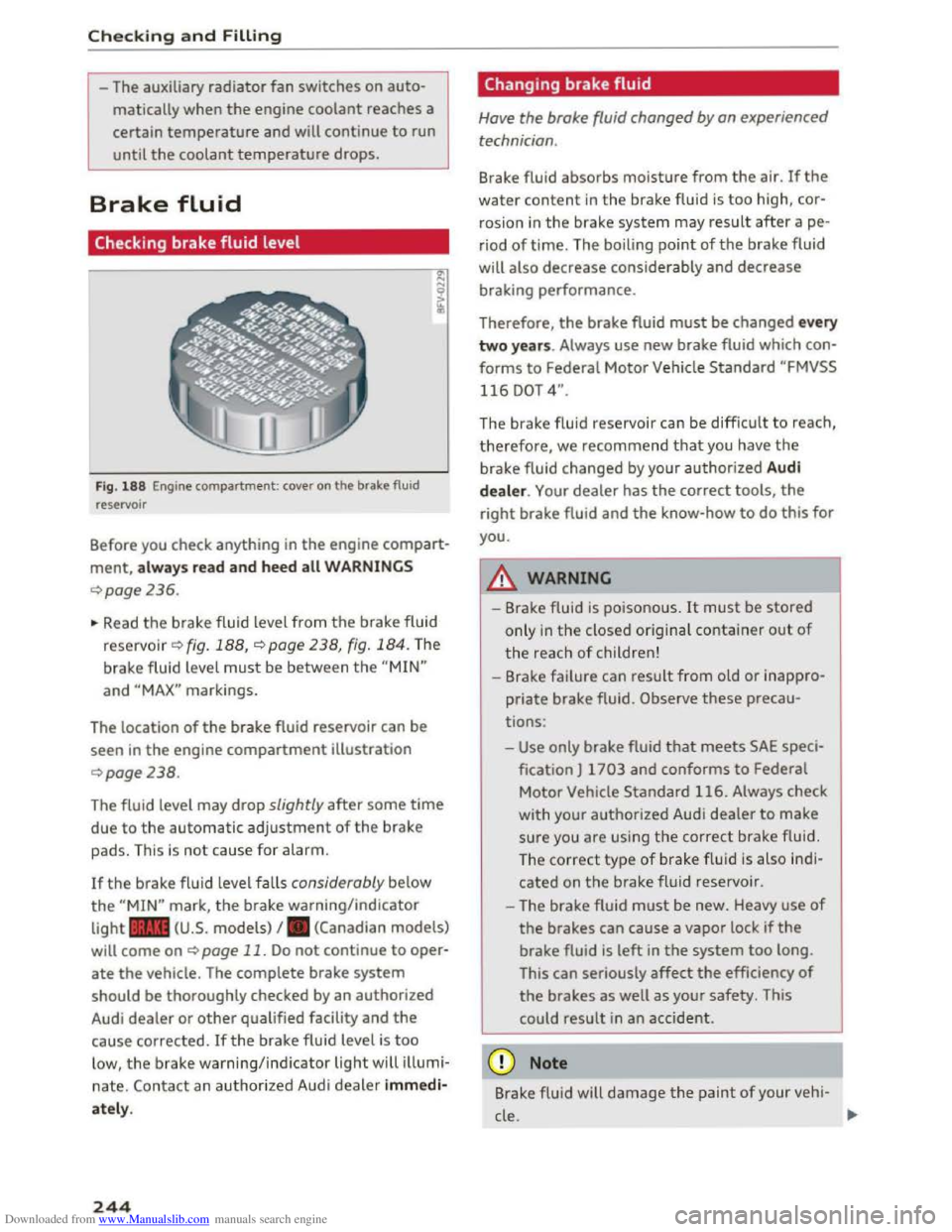
Downloaded from www.Manualslib.com manuals search engine Checking and Filling
-The auxiliary radiator fan switches on auto
matically when the engine coolant reaches a
certain temperature and will continue to run
until the coolant temperature drops.
Brake fluid
Checking brake fluid level
Fig. 188 Engine compartment: cover on the brake fluid
reservoir
Before you check anything in the engine compart
ment, always read and heed all WARNINGS
¢page 236.
~ Read the brake fluid level from the brake fluid
reservo ir ¢ fig. 188, ¢page 238, fig. 184. The
brake fluid level must be between the "MIN"
and "MAX" markings.
The location
of the brake fluid reservoir can be
seen in the engine compartment illustration
¢page238.
The fluid level may drop slightly after some time
due to the automatic adjustment of the brake
pads. This is not cause for alarm.
If the brake fluid level falls considerably below
the "MIN" mark, the brake warning/indicator
light .. (U.S. models) I. (Canadian models)
will come on ¢ page 11. Do not continue to oper
ate the vehicle. The complete brake system
should be thoroughly checked by an authorized
Audi dealer or other qualified facility and the
cause corrected. Ifthe brake fluid level is too
low, the brake warning/indicator light will illumi
nate. Contact an authorized Audi dealer immedi
ately.
244
Changing brake fluid
Have the brake fluid changed by an experienced
technician .
Brake fluid absorbs moisture from the air. If the
water content in the brake fluid is too high, cor
rosion in
the brake system may result after ape
riod of time. The boiling point of the brake fluid
will
also decrease considerably and decrease
braking performance.
Therefore, the brake fluid must be changed every
two years. Always use new brake fluid which con
forms to Federal Motor Vehicle Standard "FMVSS
116 DOT 4".
The brake fluid reservoir can be difficult to reach,
therefore, we recommend that you have the
brake fluid changed by your authorized Audi
dealer. Your dealer has the correct tools, the
right brake fluid and the know-how to do this for
you.
8._ WARNING
- Brake fluid is poisonous. It must be stored
only in the closed original container out of
the reach of children!
-Brake failure can result from old or inappro
priate brake fluid. Observe these precau
tions:
-Use only brake fluid that meets SAE speci
fication
J 1703 and conforms to Federal
Motor Vehicle Standard 116. Always check
with
your authorized Audi dealer to make
sure you are using the correct brake fluid.
The
correct type of brake f lui d is also ind i
cated on the brake fluid reservoir .
- The
brake fluid must be new. Heavy use of
the brakes can cause a vapor lock if the
brake fluid is left in the system too long.
This
can seriously affect the efficiency of
the brakes as well as your safety. This
could
result in an accident.
CD Note
Brake flu id will damage the paint of your veh i-
cle .
JIJ.
Page 247 of 322

Downloaded from www.Manualslib.com manuals search engine ~ For the sake of the environment
Because of the problem of proper disposal of
brake fluid as well as the special tools re
quired
and the ne cessary expertise, we rec
ommend that you have the brake fluid
changed by your authorized Audi dealer.
Battery
General information
The battery in your Audi does not need any main
tenance under normal operating conditions. Audi
recommends having the electrolyte level check
by an
authorized Audi dealer or authorized Audi
Service Facility
when there are high outside tem
peratures or when driving all day. The electrolyte
level should also be checked each time the bat
tery is charged ~page 247.
Have the battery checked when you bring your ve
hicle
in for an inspection . It is a good idea to re
place
the battery if it is more than S years old.
Sometimes when the airbags deploy, the battery
will be disconnected from the vehicle electrical
system for safety reasons ~.&in Repair, care
and disposal
of the airbags on page 203.
Disconnecting the battery
The battery should not be disconnected. Several
vehicle functions (power windows, for
example)
will be lost when the battery is disconnected. The
functions must be reprogrammed after connect
ing the battery. To avo id this, the battery should
only be disconnected from the vehicle electrica l
system when it is absolutely necessary.
Not running the vehicle for long periods of
time
If you do not drive your vehicle for several days or
weeks, electrical consumers are gradually scaled
back
or switched off. This reduces energy use and
ensures the vehicle will be able to start after long
periods of time~ page 92. Some convenience
functions, su ch
as interior lighting or power seat
adjustment, may not be available under certain
circumstances. These convenience functions will
be available again once you switch
the ignition on
and start the engine.
Checking and Filling
Winter operation
A lot of stress is placed on the battery during
cold weather, which results in reduced starting
ability. Have the battery checked and recharged if
necessary
before the cold weather begins.
A WARNING
- Work on the battery requires expert know l
edge. Contact an authorized Audi dealer or
authorized Audi Service Facility for informa
tion regarding the vehicle battery. There is a
risk for chemical
burns or explosions.
- Never
open the vehicle battery. Do not try to
change the battery electrolyte level. Other
wise explosive
gas will escape from the bat
tery and increase the risk of an exp losion. ___ ....J
Working on the battery
Be especially careful when working on or near
the battery.
The battery is located in the luggage compart
ment under the floor . Before you check anything
in the luggage compartment, read and heed all
WARNINGS~_&.
Always heed the safety warnings , when working
on
the vehicle battery or the vehicle electrical
system to prevent injury.
The following WARNINGS are very important
when working on the battery:
Always heed the following WARNING SYM-
BOLS and safety precautions when working on
the battery.
®
Always wear eye protection.
&
Battery acid contain s sulfuric acid. Al-
ways wear gloves and
eye protection .
@
No
- sparks
- flames
- smoking.
245
Page 248 of 322
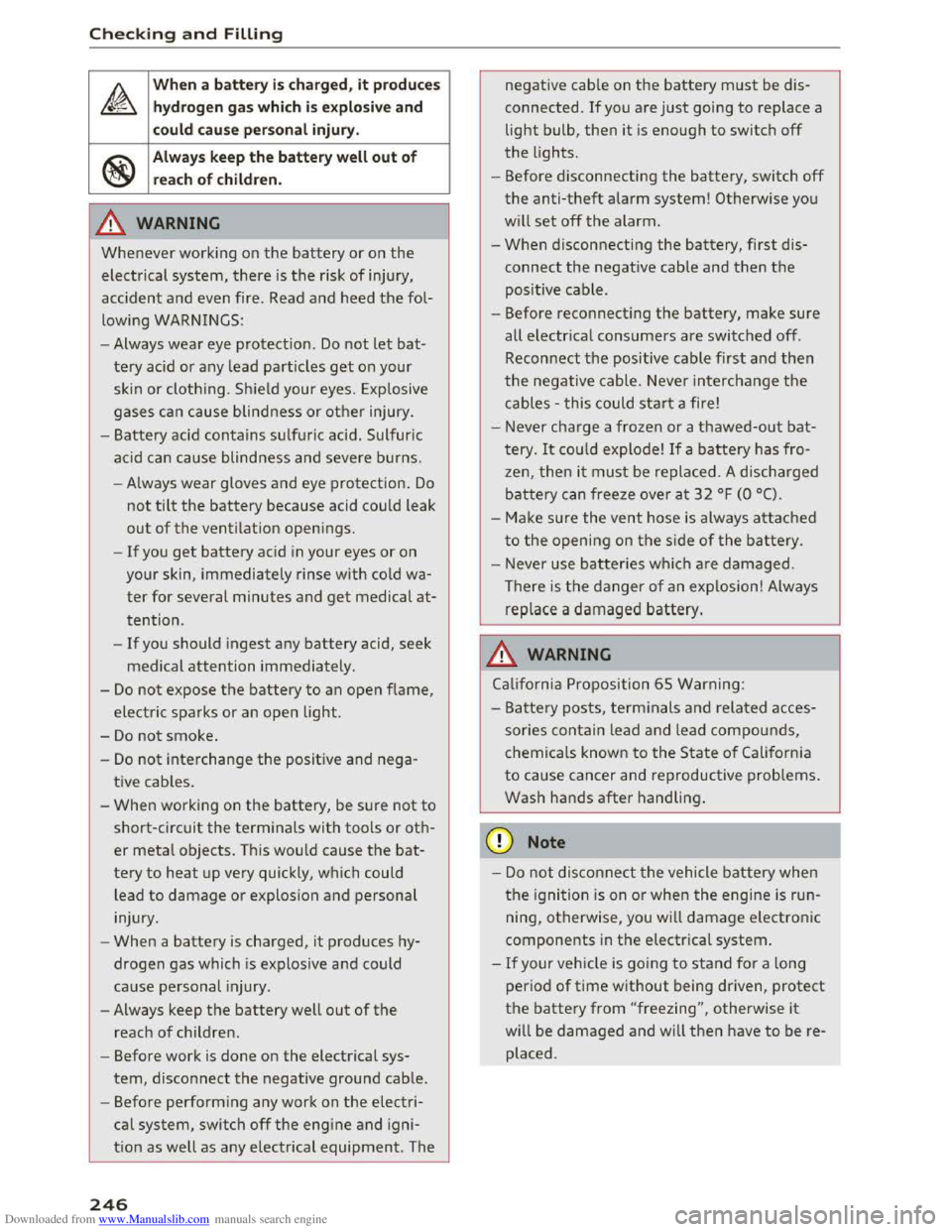
Downloaded from www.Manualslib.com manuals search engine Checking and F illing
~
When a b attery is char ged, it pro duces
hyd rogen gas whi ch i s e xplo sive and
could
cau se pers onal injury.
®
Always kee p the battery well out of
re ach of childre n.
A WARNING
Whenever working on the ba ttery or on the
electrical system, there is the risk of injury,
accident and even fire. Read and heed the fol
lowing
WARNINGS:
- Always wear eye protection. Do not let bat
tery acid or any lead particles get on your
skin or clothing . Shield your eyes. Explosive
gases can cause blindness or other injury.
-
Battery acid contains sul furic acid. Sulfuric
acid
can cause blindness and severe burns.
- Always
wear gloves and eye protection. Do
not tilt the battery because acid could leak
out of the ventilation openi ngs.
- If you
get battery acid in your eyes or on
your skin, immediately rinse with cold wa
ter for several minutes and get medical at
tention.
-
If you should ingest any battery acid, seek
medical attention immediately.
-
Do not expose the battery to an open flame,
electric sparks or an open light.
-
Do not smoke.
-Do not interchange the positive and nega-
tive
cables.
-When working on the battery, be sure not to
short-circuit the terminals with tools or oth
er metal objects. This would cause the bat
tery to heat up very quickly, which could
lead to damage or explosion and personal
injury.
-
When a battery is charged, it produces hy
drogen gas which is explosive and could
cause personal injury .
- Always keep
the battery well out of the
reach of children.
- Before work is
done on the electrical sys
tem, disconnect the negative ground cable.
- Before
performing any work on the electri
cal
system, switch off the engi ne and igni
t i
on as well as any electrical equipment. The
246
-
negative cabl e on the battery m ust be dis
connected. If you are just going to replace a
light bulb,
then it is enough to switch off
the lights.
- Before di
sconnecting the battery, switch off
the anti-theft alarm system! Otherwise you
w ill
set off the alarm.
-
When disconnecting the battery, first dis
connect the negative cabl e and then the
positive cable.
- Before
reconnecting the battery, make sure
all electrical consumers are switched off.
Reconnect
the positive cable first and then
the negative cable. Never interchange the
cables -this could start a fire!
- Never
charge a frozen or a thawed-out bat
tery. It cou ld explode! If a battery has fro
zen,
then i t must be replaced. A discharged
b attery can freeze ove r at 32 °F (O °C).
-Make sure the vent hose is always attached
to the opening on the side of the battery .
- Never
use batteries which are damaged.
There is th e danger of an exp losion! Always
replace a da maged battery .
A WARNING
Cali fornia Proposition 65 Warning:
-
Batter y posts, ter m inals and related acces
sories contain lead a nd lead compounds,
chemicals known to the State of California
to cause cancer and reproductive problems.
Wash
hands after handling .
CD Note
-Do not disconnect the vehicle battery when
the ignition is on or when the engine is run
ning,
otherwise, you will damage electronic
components in the e lectrical system.
-If your veh icle is going to stand for a long
period of time without being driven, protect
the battery from "freezing" , otherwise it
will be damaged and will then have to be re
placed .
Page 250 of 322

Downloaded from www.Manualslib.com manuals search engine Checking and Filling
Battery replacement
The new battery must have the same specifica
tions and dimensions as the original equipment
battery .
Intelligent energy management in your vehicle is
responsible for distributing the electrical energy
throughout your vehicle Q page 92. The intelli
gent energy management system will keep the
engine battery charged better than vehicles with
out this system. To make sure the additional
electrical energy is available once again after you
have
changed the battery, we recommend that
you install batteries of the same type and manu
facture only (the same as those insta lled at the
time your vehicle was delivered). Specificat ions
are listed on the battery housing. Your author
ized dealer must code the battery in the energy
management system to enable you to use the en
ergy management functions correctly after re
placing the battery.
The new
battery must have the same capacity,
voltage (12-volts) , amperage, construction and
plug sealing.
When installing the battery, make sure the igni
tion and all electrical consumers are switched
off.
CD Note
Make
sure the ventilation hose on the side of
the battery is connected, otherwise fumes or
battery acid can leak out.
@ For the sake of the environment
Because
of the problem of proper disposal of
a battery, we recommend your authorized
Audi dealer change the battery for you. Bat
teries contain sulfuric acid and lead and must
always be disposed of properly in compliance
with all
environmental regulations. Disposing
of vehicle batteries improperly is very danger
ous to the environment.
248
Windshield washer
system
Fig. 190 Eng ine compartment: washer flu id reservo ir cap
The windshield washer reservoir W contains the
cleaning solution for the windsh ield and the
headlight washer system* Q page 238, fig. 184.
The reservoir capacity is found in Q page 299.
To reduce the risk of lime scale deposits on the
spray nozzles, use clean water with low amounts
of calcium. Always add window cleaner to the wa
ter. When the outside temperatures are cold, an
anti-freezing
agent should be added to the water
so that it does not freeze .
CD Note
- The
concentration of anti-freezing agent
must be adjusted to the vehicle operating
conditions in the respective climate. A con
centration that is too high can lead to vehi
cle damage.
-Never add radiator anti-freeze or other addi
tives to the washer fluid.
-
Do not use a glass cleaner that contains
paint solvents, because this can damage the
paint.